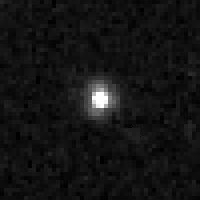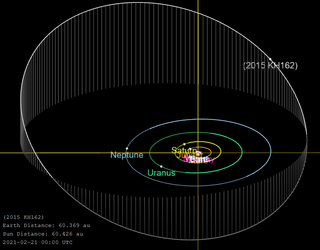Related Research Articles

(612243) 2001 QR322, prov. designation: 2001 QR322, is a minor planet and the first Neptune trojan discovered, by American astronomer Marc Buie of the Deep Ecliptic Survey at Cerro Tololo Observatory in Chile on 21 August 2001. It orbits ahead of Neptune at its L4 Lagrangian point and measures approximately 132 kilometers (82 miles) in diameter.
385571 Otrera, provisional designation 2004 UP10, is a Neptune trojan leading Neptune's orbit in the outer Solar System. It was discovered by American astronomers Scott Sheppard and Chad Trujillo at Las Campanas Observatory on 16 October 2004. It measures approximately 100 kilometers in diameter and was the second such body to be discovered after 2001 QR322.

Neptune trojans are bodies that orbit the Sun near one of the stable Lagrangian points of Neptune, similar to the trojans of other planets. They therefore have approximately the same orbital period as Neptune and follow roughly the same orbital path. Thirty-one Neptune trojans are currently known, of which 27 orbit near the Sun–Neptune L4 Lagrangian point 60° ahead of Neptune and four orbit near Neptune's L5 region 60° behind Neptune. The Neptune trojans are termed 'trojans' by analogy with the Jupiter trojans.
2005 TN53 is an inclined Neptune trojan leading Neptune's orbit in the outer Solar System, approximately 80 kilometers in diameter. It was first observed on 7 October 2005, by American astronomers Scott Sheppard and Chad Trujillo at Las Campanas Observatory in the Atacama desert of Chile. It was the third such body to be discovered, and the first with a significant orbital inclination, which showed that the population as a whole is very dynamically excited.
385695 Clete, provisional designation 2005 TO74, is a Neptune trojan, co-orbital with the ice giant Neptune, approximately 97 kilometers (60 miles) in diameter. It was named after Clete, one of the Amazons from Greek mythology. The minor planet was discovered on 8 October 2005, by American astronomers Scott Sheppard and Chad Trujillo at Las Campanas Observatory in Chile. 23 known Neptune trojans have already been discovered.

(612911) 2004 XR190, informally nicknamed Buffy, is a trans-Neptunian object, classified as both a scattered disc object and a detached object, located in the outermost region of the Solar System. It was first observed on 11 December 2004, by astronomers with the Canada–France Ecliptic Plane Survey at the Mauna Kea Observatories, Hawaii, United States. It is the largest known highly inclined (> 45°) object. With a perihelion of 51 AU, it belongs to a small and poorly understood group of very distant objects with moderate eccentricities.
(118228) 1996 TQ66 (provisional designation 1996 TQ66) is a resonant trans-Neptunian object of the plutino population in the Kuiper belt, located in the outermost region of the Solar System. It was discovered on 8 October 1996, by American astronomers Jun Chen, David Jewitt, Chad Trujillo, and Jane Luu, using the UH88 telescope at the Mauna Kea Observatories, Hawaii. The very red object measures approximately 185 kilometers (110 miles) in diameter. As of 2021, it has not been named.
(613490) 2006 RJ103 is a Neptune trojan, first observed by the Sloan Digital Sky Survey Collaboration at Apache Point Observatory, New Mexico, on 12 September 2006. It was the fifth and largest such body discovered, approximately 180 kilometers in diameter. As of 2016, it is 30.3 AU from Neptune.
(527604) 2007 VL305, provisional designation 2007 VL305, is an inclined Neptune trojan that shares Neptune's orbit in the L4 Lagrangian point. It was discovered on 4 November 2007, by astronomers Andrew Becker, Andrew Puckett and Jeremy Kubica at the Apache Point Observatory in New Mexico, United States, although images from 2005 have also been recovered. It measures approximately 160 kilometers in diameter and was the sixth Neptune trojan to be discovered. As of 2016, it is 34.1 AU from Neptune.

(612584) 2003 QX113 is a large trans-Neptunian object from the scattered disc located in the outermost region of the Solar System. It is one of the most distant objects from the Sun at 60.5 AU. It was discovered by astronomers with the Canada–France Ecliptic Plane Survey at Mauna Kea Observatories, Hawaii, when it was near aphelion on 31 August 2003. It was provisionally designated 2003 QX113.
2010 KZ39 is a trans-Neptunian object orbiting the Sun as a detached object in the outer reaches of the Solar System. The object was first observed on 21 May 2010 by astronomers Andrzej Udalski, Scott Sheppard, M. Szymanski and Chad Trujillo at the Las Campañas Observatory in Chile.
2004 KV18 is an eccentric Neptune trojan trailing Neptune's orbit in the outer Solar System, approximately 70 kilometers in diameter. It was first observed on 24 May 2004, by astronomers at the Mauna Kea Observatories on Hawaii, United States. It was the eighth Neptune trojan identified and the second in Neptune's L5 Lagrangian point.
2011 HM102 is the ninth Neptune trojan discovered. It was first observed on 29 April 2011, during the New Horizons KBO Search (268) using the Magellan II (Clay) Telescope at Las Campanas Observatory in Chile. It has the same orbital period as Neptune and orbits at the L5 Lagrangian point about 60° backwards of Neptune.
(523671) 2013 FZ27 (provisional designation 2013 FZ27) is a trans-Neptunian object located in the Kuiper belt in the outermost region of the Solar System, approximately 570 kilometers (350 miles) in diameter. It was discovered on 16 March 2013, by American astronomers Scott Sheppard and Chad Trujillo at the CTIO in Chile. Numbered in 2018, this minor planet has not been named.

2014 FC69 is a trans-Neptunian object of the scattered disc on an eccentric orbit in the outermost region of the Solar System. It was first observed on 25 March 2014, by American astronomers Scott Sheppard and Chad Trujillo at the Cerro Tololo Observatory in Chile. It is one of the most distant objects from the Sun, even further away than Sedna.

(674118) 2015 KH162 is a large trans-Neptunian object orbiting in the scattered disc region of the outermost Solar System. First observed in 2015, this minor planet is one of the most distant objects from the Sun at 60.6 AU, or twice as far as Neptune.

2013 FS28 is an extreme trans-Neptunian object from the extended scattered disc on a highly eccentric orbit in the outermost region of the Solar System. It measures approximately 466 kilometers (290 miles) in diameter. The detached, extended scattered disc object belongs to the group of extreme trans-Neptunian objects. It was first observed on 16 March 2013, by American astronomers Scott Sheppard and Chad Trujillo at the Cerro Tololo Observatory in Chile.

(678191) 2017 OF69 is a resonant trans-Neptunian object from the Kuiper belt, located in the outermost region of the Solar System in the Kuiper belt's plutino population and measures approximately 533 kilometers (330 miles) in diameter. It was first observed on 26 July 2017, by American astronomers David Tholen, Scott Sheppard, and Chad Trujillo at Mauna Kea Observatories in Hawaii, but not announced until 31 May 2018 due to observations made in April and May 2018 refining its orbit significantly.
(690420) 2014 FC72 is a trans-Neptunian object, classified as a scattered and detached object, located in the outermost region of the Solar System. It was first observed on 24 March 2014 by astronomers with the Pan-STARRS survey at Haleakala Observatory, Hawaii, United States. With its perihelion distant from Neptune, it belongs to a small and poorly understood group of objects with moderate eccentricities. It is estimated to measure 500 kilometers (300 miles) in diameter, assuming a low albedo.

2018 VG18 is a distant trans-Neptunian object (TNO) that was discovered when it was 123 AU (18 billion km; 11 billion mi) from the Sun, more than three times the average distance between the Sun and Pluto. It was discovered on 10 November 2018 by Scott Sheppard, David Tholen, and Chad Trujillo during their search for TNOs whose orbits might be gravitationally influenced by the hypothetical Planet Nine. They announced the discovery of 2018 VG18 on 17 December 2018 and nicknamed the object "Farout" to emphasize its distance from the Sun.
References
- 1 2 3 4 5 6 "JPL Small-Body Database Browser: (2008 LC18)" (2012-07-22 last obs.). Jet Propulsion Laboratory . Retrieved 4 August 2017.
- 1 2 3 "2008 LC18". Minor Planet Center. Retrieved 4 August 2017.
- 1 2 "List of Neptune Trojans". Minor Planet Center. 10 July 2017. Retrieved 4 August 2017.
- 1 2 "Asteroid Size Estimator". CNEOS/JPL. Retrieved 4 August 2017.
- 1 2 3 4 5 Lakdawalla, Emily (13 August 2010). "2008 LC15, the first Trojan asteroid discovered in Neptune's L5 point". The Planetary Society. Retrieved 4 August 2017.
- 1 2 3 4 5 6 Sheppard, Scott S.; Trujillo, Chadwick A. (September 2010). "Detection of a Trailing (L5) Neptune Trojan". Science. 329 (5997): 1304. Bibcode:2010Sci...329.1304S. doi: 10.1126/science.1189666 . PMID 20705814. S2CID 7657932.
- ↑ "Reaching the Mid-Mission Milestone on the Way to Pluto!". New Horizons : The PI's Perspective. 18 October 2010. Retrieved 9 April 2019.[ permanent dead link ]
- ↑ 2008 LC18 at JPL Horizons Change "Observer Location" to @Pluto
- ↑ Ticha, J.; et al. (10 April 2018). "DIVISION F / Working Group for Small Body Nomenclature Working Group for Small Body Nomenclature. THE TRIENNIAL REPORT (2015 Sept 1 – 2018 Feb 15)" (PDF). IAU. Retrieved 25 August 2018.